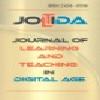Examining the Usability of e-Content in Different Forms for Increasing Digital Parenting Competencies
Examining the Usability of e-Content in Different Forms for Increasing Digital Parenting Competencies
digital parenting, videos, video usability, document usability, visually aided written material usability,
___
- Alexander, K.P. (2013). The usability of print and online video instructions. Technical Communication Quarterly, 22(3), 237-259.
- Clarkson, A., & Zierl, L. (2018). An online parenting program grows digital parenting skills and parent–school connection. Journal of Extension, 56(5). Retrieved from https://tigerprints.clemson.edu/ joe/vol56/iss5/6
- Drexler, W., Baralt, A. & Dawson, K. (2008). The teach web 2.0 consortium: A tool to promote educational social networking and Web 2.0 use among educators. Educational Media International, 45(4), 271-283.
- Freire, L. L., Arezes, P. M. & Campos, J. C. (2012). A literature review about usability evaluation methods for e-learning platforms. Work, 41(1), 1038-1044.
- Gedik, Y. (2021). A rising trend in the online world: A conceptual assessment of video marketing. Haliç University Journal of Social Sciences, 4(1), 117-157.
- Greenhow, C., Robelia, B. & Hughes, J. E. (2009). Learning, teaching, and scholarship in a digital age: Web 2.0 and classroom research: What path should we take now? Educational Researcher, 38(4), 246-259.
- Grosseck, G. (2009). To use or not to use web 2.0 in higher education? Procedia-Social and Behavioral Sciences, 1(1), 478-482.
- International Organization for Standardization /TC 159/SC 4 Ergonomics of Human-System Interaction (Subcommittee). (1998). Ergonomic Requirements for Office Work with Visual Display Terminals (VDTs).: Guidance on Usability.
- Jent, J.F., Rothenberg, W.A., Weinstein, A., Stokes, J., Barnett, M., Srivatsa, N., Dandes, E., & Garcia, D. (2021). Comparing traditional and ebook-augmented parent child interaction therapy (PCIT): A randomized control trial of pocket PCIT. Behavior Therapy, 52(6), 1311-1324.
- Korat, O. & Shamir, A. (2007). Electronic books versus adult readers: Effects on children’s emergent literacy as a function of social class. Journal of Computer Assisted Learning, 23(3), 248-259.
- Krull, G. & Duart, J. (2017). Research trends in mobile learning in higher education: A systematic review of articles (2011 – 2015). International Review of Research in Open and Distributed Learning, 18(7), https://doi.org/10.19173/irrodl.v18i7.2893
- Lewis, J. R. (2006). Usability testing. In G. Salvendy (Eds.), Handbook of human factors and ergonomics (1275-1316). John Wiley & Sons, Inc. https://doi.org/10.1002/0470048204.ch49
- Muruganantham, G. (2015). Developing of E-content package by using ADDIE model. International Journal of Applied Research, 1(3), 52-54.
- Nielsen, J. (2000). Web usability. Apogeo Editore.
- Pekyürek, M.F., & Yıldız-Durak, H. (2021). Eğitim alanında kullanılabilecek görsel destekli yazılı materyallerin ve videoların kullanılabilirlik testinin geliştirilmesi. 12. Uluslararası Bilimsel Araştırmalar Kongresi (UBAK) 16-17 Aralık 2021 / Online, Ankara, s. 21-22.
- Sancar-Tokmak, H., Doğusoy, B. & Bilgiç, K. (2020). Examination of usability research articles published within the years 2014-2019 in Turkey. Educational Technology Theory and Practice, 10(1), 280-320. https://doi.org/10.17943/etku.639383
- Sarıtepeci, M., & Durak, H. (2016). Digital storytelling effect on students' motivation in subject of information technologies fundamentals. Journal of Research in Education and Teaching, 5, 258-265.
- Saritepeci, M. (2021). Students’ and parents’ opinions on the use of digital storytelling in science education. Technology, Knowledge and Learning, 26(1), 193-213.
- Schroeder, R. (2004). Interactive info graphics in Europe added value to online mass media: A preliminary survey. Journalism Studies, 5(4), 563-570.
- Taşdemir, E., Bilkan, N., Can, H. (2004). Türkçe Öğretim Teknikleri. İzmir: Dilset Yayınları
- Vural, B. (2013). Information communication technologies and utopian perspective. Selçuk İletişim, 5(3), 5-19.
- We Are Social (2022). Digital 2022: Your ultimate guide to the evolving digital world. Retrieval from [https://wearesocial.com/uk/blog/2022/01/digital-2022/] on 11.05.2022.
- Yaman, F., Dönmez, O., Akbulut, Y., Kabakçı-Yurdakul, I., Çoklar, A.N., & Güyer, T. (2019). Exploration of parents’ digital parenting efficacy through several demographic variables. Education and Science, 44(199), 149-172.
- Yıldız-Durak, H. (2018). Digital story design activities used for teaching programming effect on learning of programming concepts, programming self‐efficacy, and participation and analysis of student experiences. Journal of Computer Assisted Learning, 34(6), 740-752.
- Yurdakul, İ.K., Dönmez, O., Yaman, F., & Odabaşı, H.F. (2013). Digital parenting and changing roles. Gaziantep University Journal of Social Sciences, 12(4), 883-896.
- Zhang-Kennedy, L., Abdelaziz, Y., & Chiasson, S. (2017). Cyberheroes: The design and evaluation of an interactive ebook to educate children about online privacy. International Journal of Child-Computer Interaction, 13, 10-18.
- Yayın Aralığı: 2
- Başlangıç: 2016
- Yayıncı: Mehmet Akif Ocak
Effects of Cognitive Load Level on Students’ Attitude towards the Gamified Course
Begüm SERTYEŞİLIŞIK, Egemen SERTYEŞİLIŞIK
Students’ Opinions on the Usage of Mobile Augmented Reality Application in Health Education
Filiz METE, Berra ALİBAŞİÇ, Beyza KÖKSAL
Development and Validation of the Teachers’ Digital Competence Scale (TDiCoS)
Duygu YILMAZ ERGÜL, Mehmet Fatih TAŞAR
Examining The Prediction of Digital Game Addiction Awareness on Digital Educational Game Usage
Burcu KARABULUT COŞKUN, Arif AKÇAY
Mehmet Fatih PEKYÜREK, Hatice YILDIZ DURAK, Mustafa SARITEPECİ, Yıldız ÖZAYDIN AYDOĞDU, Eda AKDOĞDU YILDIZ
